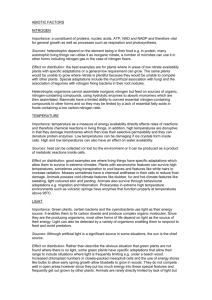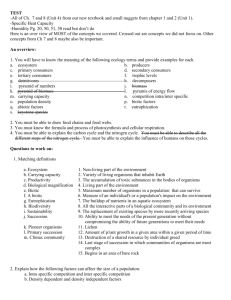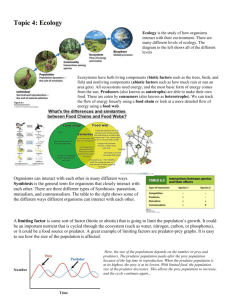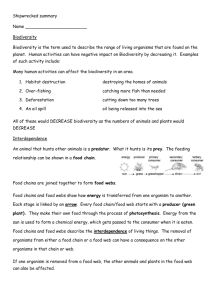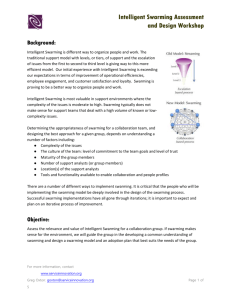Nitrogen - Rosshall Academy
advertisement
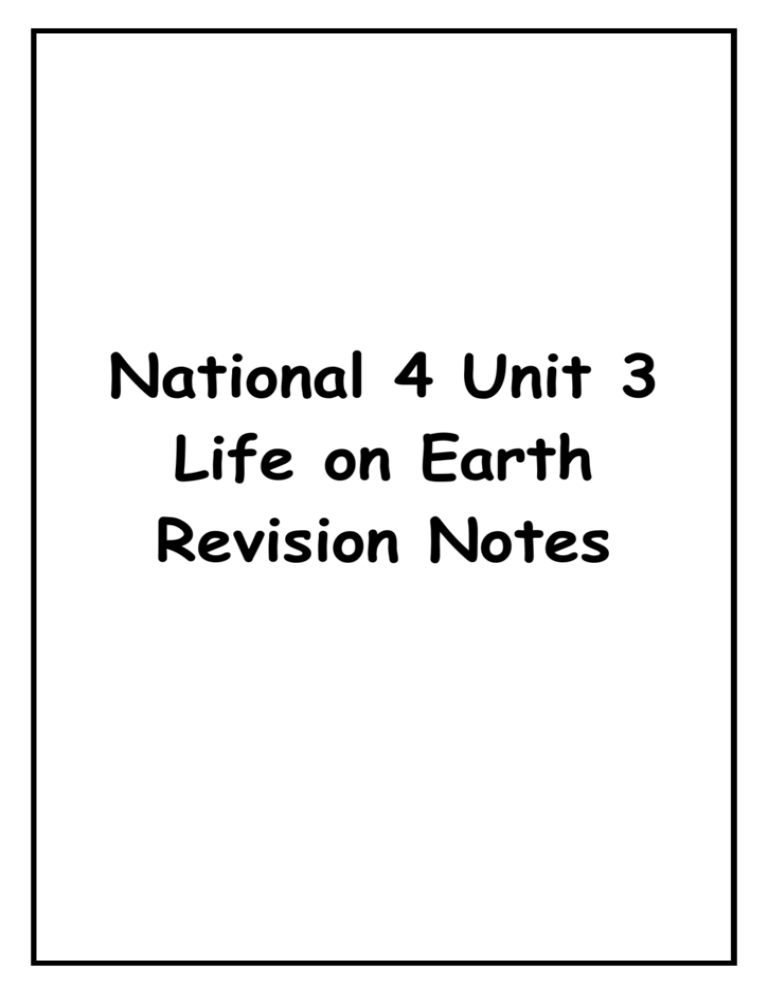
National 4 Unit 3 Life on Earth Revision Notes Key Area 1 – Animal and plants species depend on each other Food webs are made up of lots of food chains. Plants Rabbits Foxes is an example of a food chain from the food web above. The foxes eat the rabbits and the rabbits eat the plants. If an organism is wiped out of the food web (for example through disease) then the organisms around it might increase, decrease or stay the same in number. For example, if the population of rabbits were to be wiped out then the fox’s numbers might decrease because there would be less food for them. Page 2 Key Area 2 – Impact of population growth and natural hazards on biodiversity Biodiversity means the variety of life. Habitat destruction Habitat destruction is the process in which natural habitat is rendered functionally unable to support the species present. Deforestation Deforestation describes the removal of vast areas of natural forest for the benefit of humans. This can result in habitat destruction, a reduction in soil fertility and poor soil structure leading to a decrease in biodiversity. Over-fishing Overfishing is a form of overexploitation in which fish stocks are depleted to unacceptable levels, regardless of water body size. Intensive agriculture Intensive agriculture occurs when farms produce large qualities of (either animal or plant) food but to do this they have to spray large volumes of pesticides and fertilisers which can pollute the local area (especially nearby rivers). Genetic pollution Genetic pollution is the term used when genes from the genetically engineered organisms mix with natural organisms. Oil spills An oil spill is the release of oil into the environment, especially marine areas, due to human activity, and is a form of pollution. Page 3 Key Area 3 – Nitrogen cycle Nitrogen is essential for all organisms to make proteins. Nitrogen has to be cycled around the ecosystem or it would run out. Bacteria are involved in converting the nitrogen found in dead plants and animals and converting it into nitrates. Page 4 Key Area 4 – Fertiliser design and environmental impact of fertilisers Nitrogen can be added to the soil in the form of nitrate fertilisers, manure or compost. When crops are harvested, nitrogen is taken out of the cycle so needs to be replaced. Some farmers also add clover plants as they have special roots that can covert nitrates into nitrogen. Nitrogen, phosphorus and potassium help plants grow and because of this are very important parts of fertilisers. Nitrogen in fresh water increases algal growth, blocking out the light. This causes death of organisms, decrease of oxygen and means less life can be supported. Page 5 Key Area 5 – Adaptations for survival Adaptations can be structural, physiological or behavioural and help organisms survive and reproduce in their environment: 1. Behavioural - responses made by an organism that help it to survive/reproduce 2. Physiological - a body process that helps an organism to survive/reproduce 3. Structural - a feature of an organism’s body that helps it to survive/reproduce The Emperor Penguin lives in the Antarctic environment, which is very cold. The ground is covered in ice and snow and food is only available in the sea. Behavioural adaptations Adult male penguins huddle together during winter. This helps them to avoid heat loss and survive until spring. They breed during the winter so that their offspring reach independence in summer when more food is available. Physiological adaptations Males can go without food for around 100 days. This allows them to survive during winter when no food is available. A penguin’s resting heart rate can slow down greatly during a dive so that it can conserve oxygen underwater and spend more time finding food. Structural adaptations Penguins have a short stiff tail. They can lean backwards and balance on their heels and their tail. This reduces heat loss from their feet to the ground. The colour of a penguin’s body helps to camouflage it when it is swimming. From above, its dark back blends in against the sea and from below, its light front blends in against the sky. Page 6 Key Area 6 – Learned behaviour in response to stimuli linked to species survival Communication Bee-keepers have long puzzled over the mysterious little performance, which bees stage for their hive-mates when they return home from a foraging mission. On entering the hive after gathering nectar, a bee will run around in a tight figure of eight dance, waggling its abdomen as it does so. All the other bees gather around, apparently scrutinising the ceremonial manoeuvre. The direction the bees point while performing the dance indicates the direction of the food source in relation to the Sun; while the intensity of the waggles indicate how far away it is. E.g. Bees do a waggle dance to show others where food is. Imprinting Newly hatched birds of some species learn to recognise their mother and form an attachment to her. They will then follow her around and gain food and protection. This learned behaviour is called imprinting. E.g. Ducklings will follow the first creature they see after hatching (they see that organism as mum). Migration Migration is the usually seasonal movement of animals in pursuit of food, suitable breeding sites or to escape bad weather or other environmental conditions. Mass migrations - such as the wildebeest crossing the Mara River, or Pacific salmon heading upstream to mate - create some of the world's greatest wildlife spectacles. Page 7 E.g. Swallows fly to Africa in winter due to shorter daylight hours, colder temperatures and less food. Swarming Swarming happens when animals gather or travel together in large numbers. Its most familiar examples are in insects, such as locusts and midges, flocking birds and shoaling fish. Some animals swarm as a defence against predation, others, such as locusts and bees, only form swarms in specific circumstances. Swarming can be carried out by the smallest and simplest micro-organisms, such as bacteria, and even by humans. E.g. Locusts move in large numbers. Associative learning The monarch butterfly has a bright orange colour and an unpleasant taste to birds. As a result of feeding experiences, birds avoid eating orange butterflies as they have learned to associate their colour with the unpleasant taste. Habituation Habituation allows animals to avoid wasting energy by responding to repetitive harmless stimuli. A snail will withdraw its body when its shell is tapped. This withdrawal response is an innate behaviour that helps it to avoid predation. If the snail’s shell is tapped repeatedly, but the snail is not attacked by a predator, then the snail stops making the withdrawal response. Page 8
